(Eighth of ten articles about the Kent Heitholt murder in 2001 with a primary focus on interpreting the physical and other crime scene evidence that has been made available over the Internet. This article looks at deductions that can be made from the evidence as to what the assault weapon was. The analysis is limited as most of the images of victim’s injuries have not been reviewed firsthand necessitating reliance upon brief verbal descriptions of other experts.)
In the Kent Heitholt murder, identifying the assault weapon is highly important in that it can possibly help identify the killer. The assault weapon might be so specific an item as to point only to the killer and eliminate others from being considered as suspects.
At the 2005 Ryan Ferguson trial, Charles Erickson said the assault weapon was a tire tool taken from the trunk of Ryan Ferguson’s car.
In 2012, the Appeal team for Ryan Ferguson had Pathologist Larry Blum evaluate the autopsy report and findings by Pathologist Adelstein along with other evidence in the case. Pathologist Blum developed an opinion that the assault weapon was not a tire tool.
One reason was that a tire tool would most likely have fractured the skull. He said the injuries were instead consistent with a nail puller that could induce dual spaced injuries along with elongated line injuries.
Thus both a tire tool and a nail puller had been advanced as the assault weapon prior to the start of this investigation in November of 2013.
One important consideration should be whether or not there was only one weapon or perhaps two weapons. Another important consideration should be whether or not some of the victim’s injuries had resulted from something other than the assault weapon.
Tire tools, nail pullers, and long handle pliers were among the tools given consideration early on as the likely assault weapon. A piece of wood was mentioned during Pathologist Adelstein’s trial testimony and has also been given consideration.
The large number of apparent weapon strike markings to the victim’s Nissan Maxima suggest an assault weapon with enough width to require a two handed grip. With a one handed grip weapon, one would not expect much contact, if any, of the weapon with the vehicle in order to strike a person’s head positioned close to the vehicle. A similar observation also applies to the weapon scrub markings to the left rear wheel cover. These scrub markings parallel to the wheel cover infer a two handed grip weapon.
Beyond that, the apparent weapon strike markings on the lower middle of the left rear door at location 16 infer a near straight edge width of the assault weapon roughly estimated as about 8 to 10 inches. Further analysis based on door width features can yield a closer estimate of this apparent width.
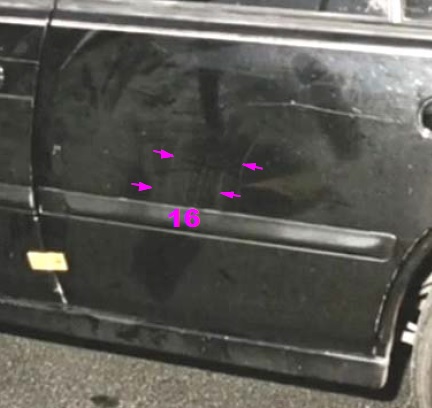
Also, the left rear tire markings at location T1 infer an estimated width of the assault weapon at one plus inches. Further analysis based on knowing an exemplar tire sidewall tread spacing would yield a closer estimate of this apparent width.
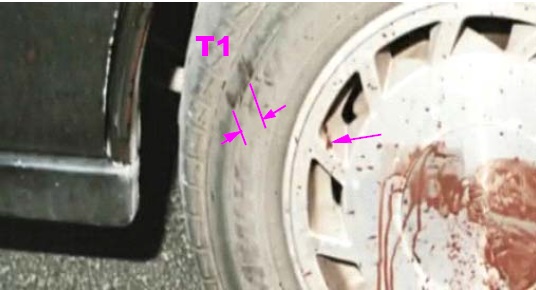
So the vehicle markings suggest a rectangular type tool with a near straight edge width of about 8 to 10 inches and a thickness of about one plus inches and an unknown length. The reported laceration injuries to the top of the victim’s head infer the assault weapon needed a straight edged surface capable of inducing skin lacerations. The weapon also needed to have a right angle edge feature.
The reported one centimeter diameter circular contusion and laceration markings to the victim’s forehead infer the assault weapon needed a rounded feature with a defined edge of about 3/8 inch.
As these circular markings reportedly only appear on the forehead, some consideration should be given to an alternate causation other than the assault weapon. One possibility would be a foot stomping by the killer of the forehead area with shoes having rounded hard rubber cleat features similar to those worn by the victim at the time of the assault and pictured below.
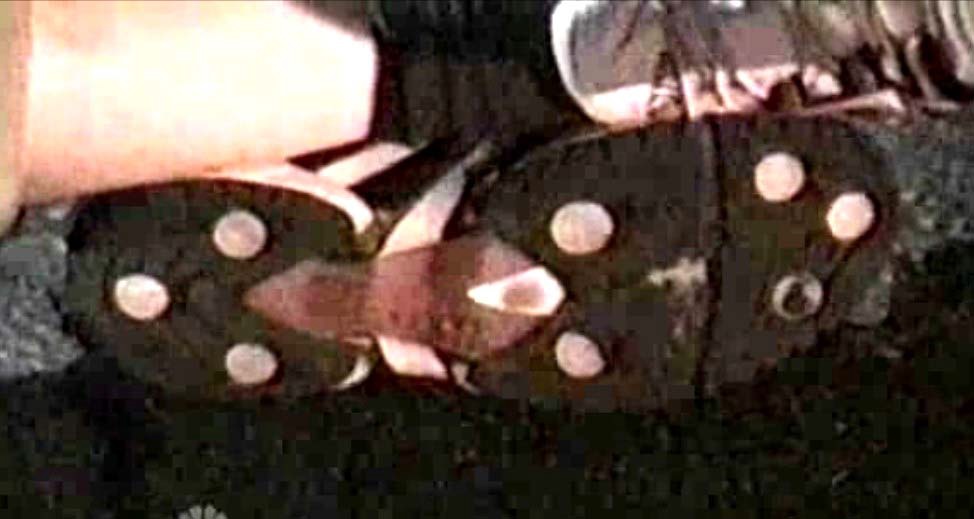
The foot stomping possibility should be closely examined. If deemed viable, it would indicate the killer was wearing a specific sports shoe that is not all that common. A person of interest suspect might be connected to this type of shoe by store sale or other means.
Elsewhere, the victim’s hands and arms experienced multiple injuries that appeared caused by blows from the assault weapon. At least six separate blows with an assortment of differing injuries were observed in the one available image of the left hand. Most of the injuries to the left hand appeared to be abrasion type injuries. Pathologist Adelstein’s said at the 2005 trial that many of the defensive injuries to the hands and arms were abrasive in nature.
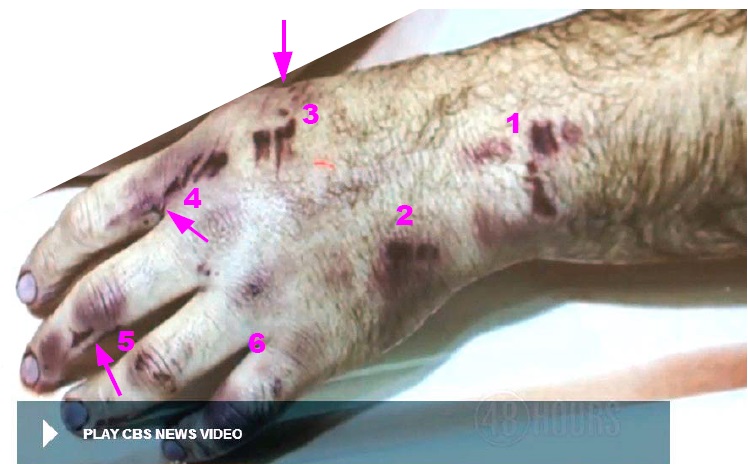
Some of the injuries to the hands and arms had a closely spaced dual contact nature. This likely influenced Pathologist Blum’s selection of a nail puller as the assault weapon.
Pathologist Blum makes a sound point with regard the tire tool not likely being the assault weapon as the victim’s skull was not fractured and one would project the tire tool as likely to do that. However the nail puller he promotes is also problematic in terms of its tip end design and the injuries it would likely produce.
For one, the typical spacing between the tip ends of nail pullers is about one quarter inch as inferred from a check of several representative nail pullers. This is needed to allow the nail puller to slide forward enough to securely grab the head of the nail. When striking an object such as human flesh, one would expect dual contact marking injuries spaced apart by about one quarter inch. When looking at the dual marks on the left hand at location 2 on the left hand we can see that the spacing appears much less than one quarter inch and not what one would expect if made by a nail puller.
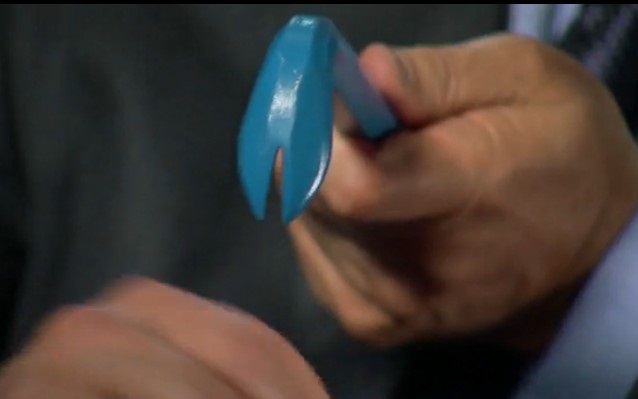
Another problem with a nail puller is that one would project that a nail puller would have a strong tendency to rip or tear the flesh as opposed to inducing an abrasion as seen at location 2. Still another problem is that the tips of the nail pullers would focus the blow on two small or narrow edges and have a strong tendency to fracture the skull with a forceful blow. Also a nail puller could not produce some of the apparent scrub and other contact markings noted to the side of the vehicle and left rear tire and wheel.
Over and above the arguments against the nail puller, the vehicle markings present a picture of an entirely different appearing assault weapon. Based on the inferences drawn from the weapon markings on the vehicle, all hand tools such as tire tools, nail pullers, and long handled pliers should be eliminated from consideration as the assault weapon.
Instead, the assault weapon requires a two handed grip, is likely rectangular in nature with one side being about 8 to 10 inches in width, and has a thickness of one plus inches. At least one straight edge needs to end with a right angle corner to be able to create a laceration on the top of the victim’s head.
The assault weapon also needs features capable of inducing closely spaced dual abrasions along with an assortment of other abrasion markings. In addition the assault weapon may need to be able to produce rounded contusions or lacerations. Another consideration is that the assault weapon needs to be able to stun and daze a victim while creating deep lacerations but not likely to fracture his skull.
Based on the numerous striking marks to the vehicle and the multiple injuries to the victim, the assault weapon was likely swung at the victim between 30 to 40 times. Many of these were short strokes. So the assault weapon needs to be reasonably lightweight but effective using short striking blows. Additionally, the assault weapon needs to have a material or finish capable of making notable scrub markings on window glass.
If we project that a stranger attacked Kent Heitholt as a chance opportunity for whatever reason, then he may have picked up something to use as a weapon from the brick trash bin enclosure. One possibility could be a scrap piece of 2 by 10 wood board with a length of about 15 or so inches. Smooth finished 2 by 10 wood boards have an actual thickness of about 1-1/2 inches and an actual width of about 9-1/4 inches. A 2 by 10 board would have a fairly close approximation to the above size criteria for the assault weapon. Another possibility would be a 2 by 12 board which would be 1-1/2 inches thick and 11- 1/4 inches wide. However the 2 by 12 board would be heavier and harder to wield by an attacker as well as being outside the estimated width range.
A piece of 2 by 10 wood can have embedded nails and an assortment of other attached metal features such as staples and bolts and bolt heads. For instance, a couple of nail heads can be closely imbedded and slightly raised such that they would produce dual abrasion markings if making strong contact with someone’s skin. Wood blocks such as this can have a variety of modifications to its width, length and thickness. Such wood blocks can also have a variety of finishes.
If part time sportswriter Mike Boyd was assumed to be the attacker, one would project that the attack was not planned as Boyd would have realized that several persons in the building could have emerged at any time and all likely knew him personally. So, in Boyd’s case, one would project an unplanned suddenly enraged attack where the assault weapon would have been a weapon of opportunity. This weapon would likely have already been in his hands or easily reached in his car at the moment of deciding to attack. Conceivably Boyd may have had a scrap piece of 2 by 10 wood board in his car. We
know that Boyd had recently been given access to a notebook computer for use in his job. In addition, he likely had a need for a clipboard in his field assignments. Some clipboards are metal and have a box type construction to hold papers or forms. Boyd may have owned a metal box shaped clipboard. Both of these rectangular box type items were given consideration as the possible assault weapon.
Now let’s briefly move our discussion to some injuries on the left hand that may not have been directly induced by the assault weapon.
In taking another look at the victim’s injuries to his left hand and wrist, we note that the group 1 injuries are in the locale of where he wore his Timex watch. This watch was missing and never found after the victim’s body was discovered. In fact the group 1 injuries appear reasonably consistent with being induced by the watch after it was struck by the assault weapon. The following photo has rectangular assault weapon overlay outlines at the six injury sites along with an overlay outline of the Timex watch at site 1.
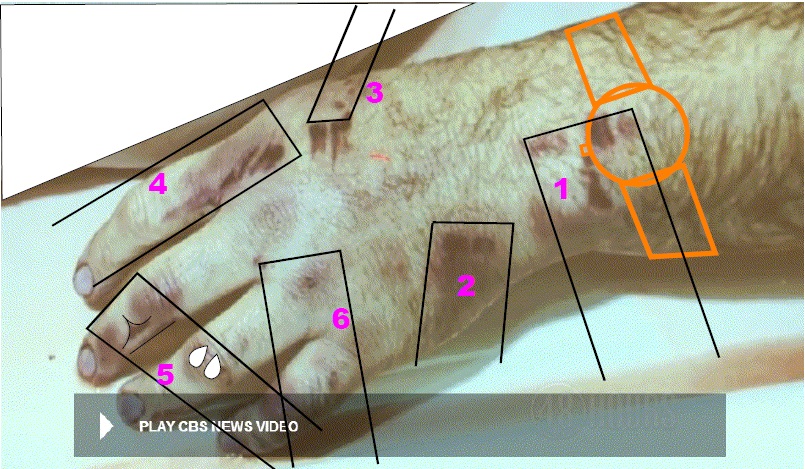
From the photo above, we can see that most of the markings at locale 1 were consistent of having been made by the victim’s watch after it had been struck by the assault weapon. This suggests the watch had likely been destroyed during the assault and suggests the motive for taking the watch may not have been robbery.
Two possibilities come to mind. One is the watch had hands that were stopped after being hit by the assault weapon and gave the exact time of the assault. In this instance the killer took the watch so that the exact time of the assault could not be determined from the watch. A second possibility would be a contract beating turned murder where the killer couldn’t find any identification on the body and took the watch and keys to prove the assault and collect the contract money.
Now let’s move our discussion back to the assault weapon.
Three differing objects have been proposed for the assault weapon and they are a wood block, metal clipboard with paper enclosure, and a notebook computer. None of the three objects can be eliminated from consideration at the level of this investigation which lacks direct access to much of the crime scene and autopsy evidence.
The notebook computer being used by Mike Boyd should be the easiest to check out and eliminate from consideration if found to be fully functional after the murder of Kent Heitholt. The metal clipboard box also should be easy to check out to see if Mike Boyd owned or had possession of one at the time of the murder.
A wooden block is difficult to eliminate as it can have a wide number of variable shapes, added metal features, and an assortment of finishes.
Also other rectangular objects can’t be excluded from consideration at this time.
Unexplained debris type material at the crime scene should be examined to ascertain if it might be consistent with items that may have come from the assault weapon. A case in point is a torn piece of paper with a phone number found next to the victim’s body after the resuscitation efforts had ceased. This paper fragment should be examined to see if it belongs with Heitholt’s materials or possibly belonged to the killer. Another possibility would be whether or not the paper fragment had originally been contained within the assault weapon.
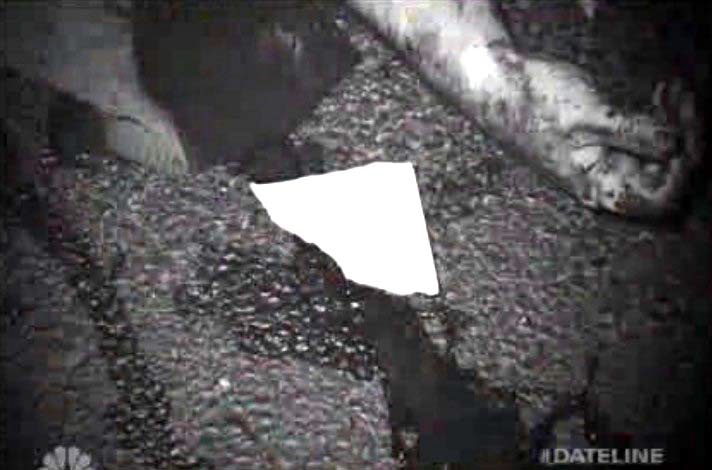
The clothing of the victim can be closely inspected for small specs of foreign material such as wood, metal flakes, or painting finish. Metal flakes or metal coating could be spectrum analyzed to help identify the assault weapon. This could also be done with the severed belt buckle.
The possibility that two assault weapons were used can’t be fully addressed at the level of this investigation. However, everything known about the crime scene and the injuries is consistent with a life and death struggle between one attacker and a victim. A strong determination of the assault weapon can possibly identify the killer while also providing evidence for his conviction. An opportunity to review quality images of all the injuries to the victim along with quality police photos and videos of the pavement and vehicle would likely result in a firmer determination of the assault weapon.
Part 9 of the series will be posted tomorrow 2/27/14
You can view the series of articles here.
 Wrongful Conviction News an Injustice anywhere website
Wrongful Conviction News an Injustice anywhere website
